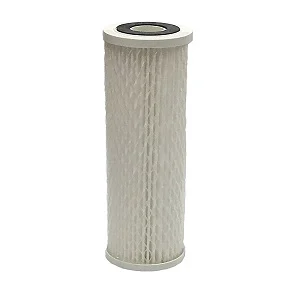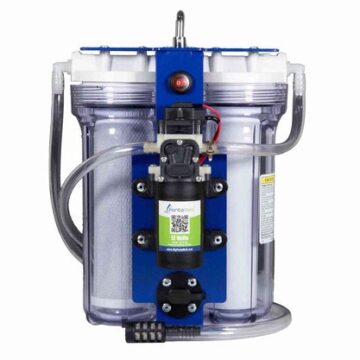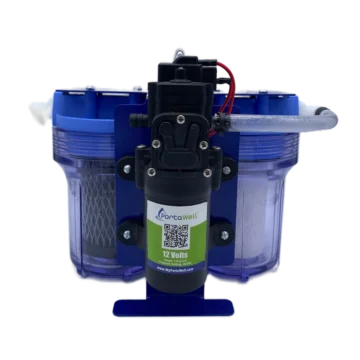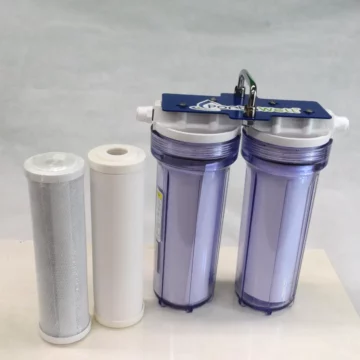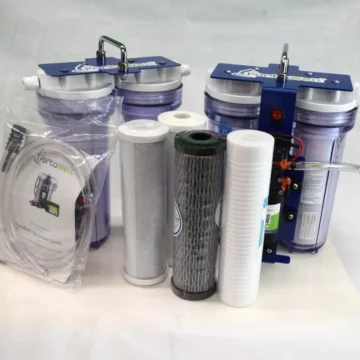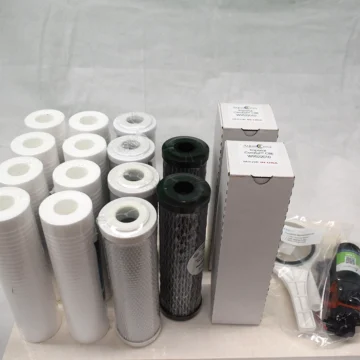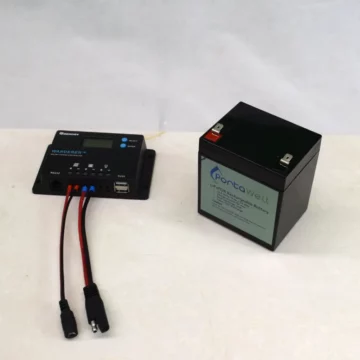Water Sustainability: Powering Your PortaWell® System

Sustainability is a key element especially when it comes to water and PortaWell can help provide sustainable water in an emergency. Clean water is required in any emergency and survival situation and your ability to produce drinkable water for you and your family or small group will be an asset.
Don’t I need Electricity?
Some people worry that the PortaWell® system requires electric power to operate and product sustainable water. However, this is what gives you the ability to produce sufficient water in a short amount of time. In a grid down or off-grid situation you may not have access to electricity, so your ability to provide your 12V power will determine how long you can survive. The good news is battery technology has advanced significantly in the past decade, and the ability to have and sustain a dependable 12-volt supply is more attainable and affordable than ever before. Some people have also worried how vulnerable the PortaWell is to an Electro Magnetic Pulse (EMP) event. Table 1 at the bottom of this post provides details and actions to protect sensitive electronic components from EMP damage.
What are my Options?
To help with water sustainability, a simple system consisting of a 12-volt battery, a small solar panel with charge controller and the correct interconnecting cables can assure you have power to run your PortaWell. This will supply you and your family with life sustaining water as long as you have an adequate source of surface water and sunshine.
The PortaWell® system requires a 12V power source — here are some possible power sources you could use:
- 110V Outlet
- Using a 110V AC to 12 volts adapter is an option to power your PortaWell® system. In a grid down or off grid situation this won’t be an option, but many portable power stations or generators have AC inverters available.
-
- In those situations, we recommend using the 12V power option on your generator or portable power station because it will use less energy and be more efficient. (The inverter has power loss when converting from DC to AC power).
- Portable Power Station
- There are many options today for these portable 12-volt power stations and they have a large range of different capacities. This is probably our favorite option for powering your PortaWell® system as they are compact, portable, and often very easy to recharge. There are many options available for purchase online (most made in China with ever changing brand names.)
- 12V battery
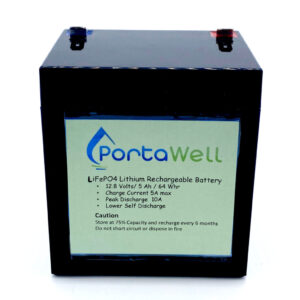
- When we think of this option, we often think of our car battery. Yes, you can use your car battery to power your PortaWell® system, however, we would recommend you only rely on that in a pinch or as a last resort. This is because car batteries are designed to provide high cold cranking amps for a short time and have a very low depth of discharge tolerance.
-
- Instead, we recommend purchasing a LiPO4 battery instead of a lead acid battery. The LiPO4 batteries are much lighter and support many more charge cycles compared to a lead acid battery. A small 5AH LiPO4 battery costs less than $40 and can run your PortaWell® system for an hour and produce 40 to 60 gallons during that time. It can be recharged in as little as a few hours (depending on your solar setup and sunlight conditions).
Your PortaWell® system should not be run directly off a solar panel because a 12-volt panel doesn’t provide the correct, well-regulated voltage.
Using solar energy to charge your 12V power source involves two main components — the solar panel(s) and a charge controller. It is perfectly acceptable to run your PortaWell off a battery while charging your battery at the same time with a solar panel and charge controller.
Note that some portable power stations have a built-in charge controller and therefore you can connect solar panels directly to them for easy charging.
Let’s talk about some things to be aware of about batteries, solar panels, and solar charge controllers to help with water sustainability.
Batteries
The battery selected to operate the PortaWell should have the following characteristics:
- Chemistry—Lead Acid, Lithium Ion, or Lithium Iron Phosphate
- Voltage—Nominal 12 volts (Fully charged Lead Acid battery (12.6 volts), Lithium-Ion battery (12.6 volts), Lithium-Ion Phosphate battery(13.4 volts)).
- Amp-Hour—Minimum 5 Amp-hours
- Type—Deep Cycle
To maximize the number of charge/discharge cycles a battery will provide, care should be taken not to: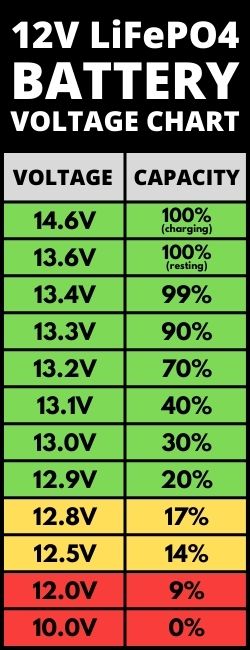
- Charge the battery too rapidly.
- Discharge the battery too rapidly.
- Discharge the battery too far before recharging.
There are differing opinions on what limits to follow but as a compromise I use the following guidelines to maximize the useful charge/discharge life of my battery:
- Charge/discharge rate should be less than approximately .5 C where C is the capacity rating of the battery in amp-hours, so for a 5 amp-hr. battery rating the charge/discharge rate should be kept to 2.5 to 3 amps (.5 x 5 = 2.5). This amperage is the typical output of a 50-to-60-watt solar panel. Using a 100-watt panel to charge this small battery would be too much but would work just fine for a 10-amp-hour battery or larger.
- Lithium based batteries can be safely discharged to a much greater depth of charge than similar rated lead-acid based batteries and still have a good service life. However, I try to never run the battery flat and limit the depth of discharge of about 80%–meaning the battery still has 20% capacity when I recharge it.
Other considerations for battery care:
- For long term storage it is best to store a lithium-based battery with 60% to 80% of full charge rather than the 100% recommended for lead acid batteries.
- Because of self-discharge, a lead-acid battery should be charged every three months and lithium-based battery every 6 months to a year.
Solar Panels
At MyPortawell.com we don’t sell solar panels for a simple reason. These components honestly can be obtained at lower costs than we could sell them for. Instead, our desire is to help you understand more about the use of solar for sustaining your PortaWell® system.
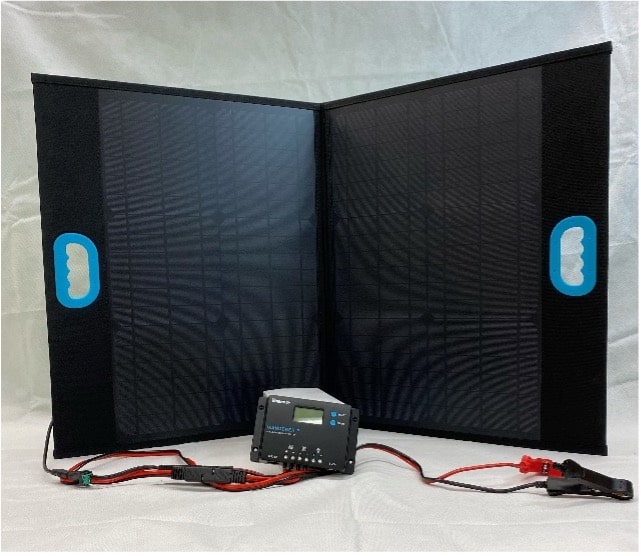
Your solar panel should be sized no greater than the maximum wattage your 12-volt battery size or Portable Power Station specifies. For example, a 5-amp-hr battery should be charged using no more than a 50 to 60 watt solar panel.
There are many options for solar panels from online vendors. A 60-watt panel can be listed for as low as $50 and as high as $200–so which should you choose?
In my experience I have found the $50 panels work just as well as the $200 ones. Most are made in China so the brand makes little difference.
My favorite portable system for powering and sustaining my PortaWell consists of a foldable 12-volt, 60-watt panel with a 5-amp-hr LiPO4 (lithium iron phosphate) battery and a 10-amp charge controller.
A similar setup can be purchased for under $150 if you look carefully.
Solar Charge Controllers
A 12-volt solar panel will typically generate 18 to 21 volts depending on the temperature, sunlight intensity and angle to the sun. The desired charging voltage for a lead-acid or LiPO4 battery is ~14.5 volts.
A Solar Charge Controller provides the interface between a solar panel and a battery. Modern solar charge controllers sense the state of charge of the battery and then adjust and control the charging voltage and current to safely and fully charge a battery. When the battery is full, the charging current is reduced or stopped (depending on battery type), to prevent overcharging and damaging the battery.
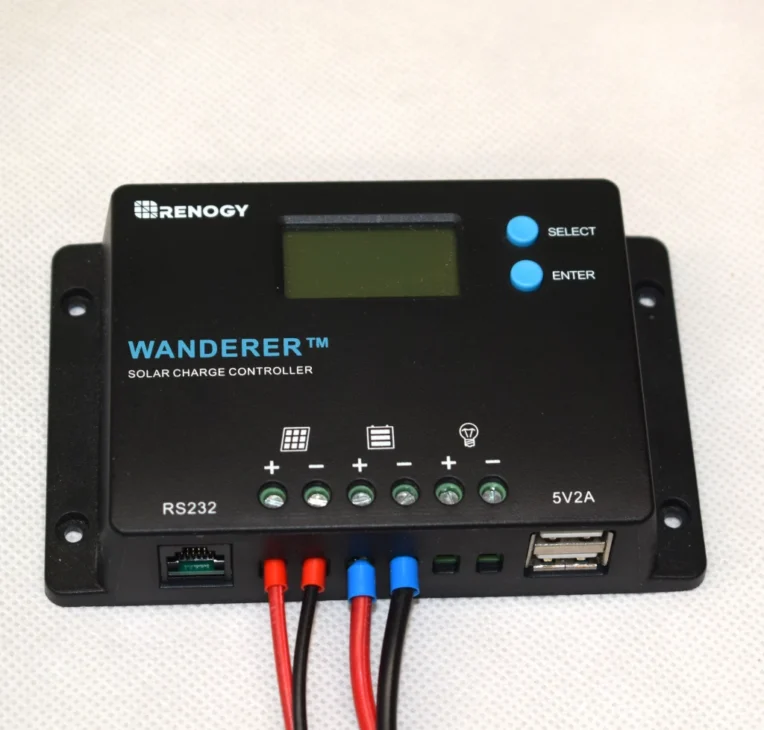
Solar charge controllers are rated by voltage and maximum current. A 12-volt charge controller rated 10 amps is sufficient to charge a 5 amp-hr. battery using a 60-watt solar panel.
Modern solar charge controllers fall into two categories: Pulse Width Modulated (PWM) and Maximum Power Point Tracking (MPPT). The MPPT type has certain advantages over a PWM including greater efficiencies especially at higher panel voltages, but for small solar charging setups (< 100 watts @ 12 volts) the increased cost is generally not worth it (MPPT costs 2 to 4 times more than PWM). There are many low-cost charge controllers that claim to be MPPT but are not really.
A 10-amp PWM charge controller can be purchased on-line for a little as $15 to $20.
Connecting Cables
The only other thing to be aware of in purchasing a solar panel is the configuration of the output cables. Connections that must be made include solar panel to charge controller and charge controller to battery. It is disappointing to purchase these components only to find the cable connector plugs are not compatible.
Solar Panel connector plugs—These are typically one of three types.
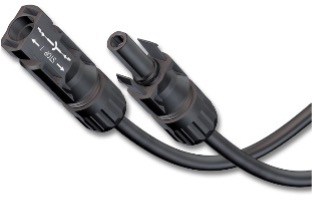 |
 |
 |
| MC4 Connector | Barrel Connector | Anderson Power Pole Connector |
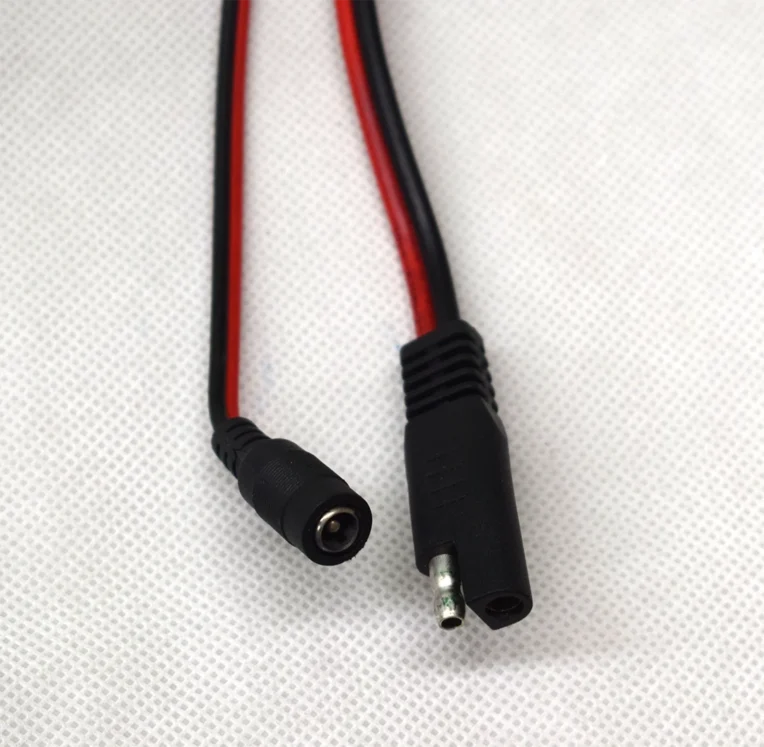
MC4 connector—This connector is more common on larger solar panels but may be found on smaller ones (less than 100 watts) as well.
Barrel connector—This connector comes in a variety of configurations but the most common is 5 mm x 2.1 mm.
Anderson Power Pole connector—This connector is more common on branded portable solar panels.
The simplest configuration to connect your solar panel to the charge controller uses the barrel connector (number 2 above). PortaWell carries premade pigtails that attach to screw terminals of most charge controllers and connects to the included SAE to battery clamp connector included with your PortaWell.
For any of the other solar panel plug configurations, pig tail transition connectors can usually be found online, or you can make your own.
Electromagnetic pulse (EMP)
Some people have also worried how vulnerable the PortaWell is to an Electro Magnetic Pulse (EMP) event. The table below provides details and actions to protect sensitive electronic components from EMP damage.
| Component | Possible Damage from EMP | Vulnerable Component | Mitigation Steps |
| PortaWell (pump) | No | None | None Required |
| Solar Panel (Portable panel in storage) | No | None | None Required |
| Charge Controller | Yes | Electronic components | Store in Faraday box1 |
| LiPO4 Battery | Yes | Battery Management System | Store in Faraday Box1 |
| Lead Acid Battery | No | None | None Required |
| Solar Power Station | Yes | Electronic Components | Store in Faraday Box1 |
1A simple Faraday box can be made by purchasing a metal garbage can with a tight-fitting lid (any size), and line the interior and bottom with cardboard.
Conclusions:
- PortaWell can supply you and your family with life sustaining water as long as you have an adequate source of surface water and sunshine.
- Sunlight is easily converted to usable electricity to recharge a 12-volt battery or Power Station to power your PortaWell using an inexpensive solar panel, charge controller and matching connecting cables.
- Watch [this video](https://www.youtube.com/shorts/52eibL03NUs) to see how easy it is to set up and recharge a battery for your PortaWell, and learn how water sustainability can be possible.
Categories
Facebook
Twitter
Email
Print
Recent Posts
Emergency Water Treatment Tutorial (Part 1) – Particulate
There are various contaminant types that can make surface water unsafe to drink and learning how best to reduce/remove these contaminants is critical to emergency ...
Read More
Selection of Surface Source Water
One PortaWell® customer asked the question: I live near the Jordan River in Salt Lake City, Utah. Could I use it as a water source ...
Read More
Sustainable Water Solution for Emergency Preparedness
sus·tain·a·bil·i·ty – Noun – the ability to maintain or support a process over time. Sustainability, as it applies to emergency preparedness, is particularly important if ...
Read More
Chlorine Water Treatment for Drinking Water
Water treatment can be a challenge in an emergency and here is the why and how chlorine will be effective in the process of creating ...
Read More
Filtering Pool Water
Filtering Pool Water – PortaWell® Many people have inquired if they can filter pool water with a PortaWell® system to make it safe for drinking ...
Read More
PortaWell® Newsletters
PortaWell® Newsletters Download and read our past newsletters with tips and tricks for using your PortaWell®: Water Filter Placement and Selection – Newsletter Volume 1 ...
Read More
PortaWell® Products
-
Argonide NanoCeram® Filter (10-inch, 0.2 micron)
$52.99Original price was: $52.99.$43.95Current price is: $43.95. -
PortaWell® Starter Pak
$379.00Original price was: $379.00.$339.00Current price is: $339.00. -
PortaWell® Mini Expedition
$279.99Original price was: $279.99.$249.00Current price is: $249.00. -
PortaWell® Expansion Kit
$165.00Original price was: $165.00.$149.00Current price is: $149.00. -
PortaWell® Plus Kit
$539.00Original price was: $539.00.$479.00Current price is: $479.00. -
PortaWell® Survivor Kit
$325.00Original price was: $325.00.$289.00Current price is: $289.00. -
PortaWell® Solar Accessory Kit
$71.95Original price was: $71.95.$49.95Current price is: $49.95. -
PortaHeat®
$349.00Original price was: $349.00.$299.00Current price is: $299.00.







